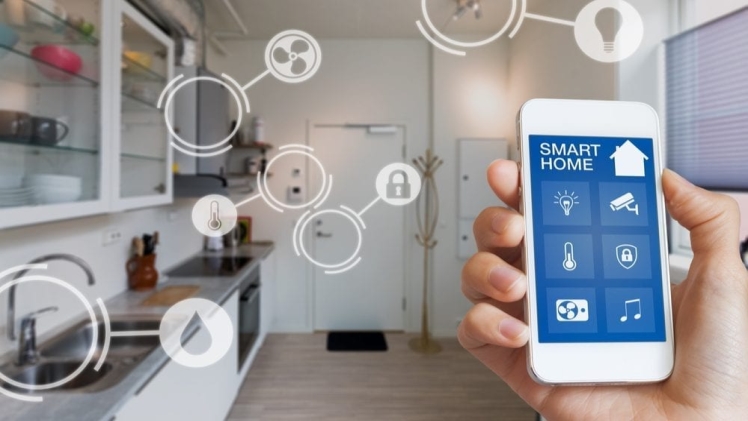You’re starting to jump on the smart home bandwagon and have installed a few devices in your house. There’s a new smart lock on the front door, and you’ve put in a new smart refrigerator. You no longer struggle with your keys when you get home from work every night. And your fridge tells you what to pick up from the grocery store to cook your favorite recipes.
Like most people, you’re enjoying the conveniences of the new technology. At first, you thought smart devices weren’t necessary. But now you can’t see yourself going back and are wondering how to make your smart home even “smarter.” With emerging tech devices and protocols, there are ways to improve upon what you’ve already started. Below are three of them.
1. Use an Enhanced Wi-Fi Solution
A complete Wi-Fi solution can augment your smart home experience by adapting to your behaviors and patterns. Built with the latest wireless standards, an adaptive Wi-Fi solution can handle more devices and deliver faster speeds. Enhanced Wi-Fi also learns which smart devices need more bandwidth and when.
So while you’re away, the system will devote the most bandwidth to your security system and thermostat. When you get home, your TV, office devices, and kitchen appliances will receive more capacity. And during your evening workout, that capacity will shift to any smart exercise equipment you use.
In addition, you’ll be able to control access to your Wi-Fi network. This includes which devices your children or guests in your home can use online. There’s also the ability to set time limits if you don’t want your kids online for more than a few hours. This is a clear departure from traditional networks where everyone and each device would connect using the same password and access.
Some Wi-Fi options let you set up a password-free guest connection, but this also opens up your network to anyone who’s nearby. With enhanced Wi-Fi solutions, you don’t have to do this. Instead, you can create separate sets of network passwords that control access levels. You can set one group for devices that need to communicate with each other and have undisturbed internet access. Another group can be for devices that don’t have to sync and only need to get online during specific times.
With these control options, you’ll be preventing some devices from taking up network capacity. More bandwidth will be available for your smart home’s most critical needs, and you’ll notice better overall performance from your Wi-Fi.
2. Integrate Your Devices
When you purchase smart home devices that support integration, you’ll gain the ability to link them together. Integration or linking allows you to automate several things within your home. Instead of sending separate commands to your smart thermostat and your outdoor lights, you can sync them. You can set up a single command that adjusts the thermostat and turns on the lights at the same time.
These commands can execute different sets of activities for various times of the day. At a designated time in the evenings, your porch lights turn on and your home’s temperature goes down. Before you wake up, the outside lights turn off and the temperature goes back up a few degrees. If you have a smart coffee maker, you can even include it in your morning set of commands. It can start brewing just before you wake up, right as the outside lights turn off.
By setting up these groups of commands, you’ll automate many of the capabilities of your smart home. You won’t have to think about a lot of the tasks you perform with your devices. And in some cases, you’ll eliminate the need for separate apps on your smartphone or tablet.
Some devices offer seamless integration through a hub, and others link through services like IFTTT. The acronym stands for “if this, then that,” and a device’s tech specs will indicate whether it supports it. With IFTTT, you’ll also have the flexibility to set individual commands and conditions for devices.
Maybe you don’t want to include your thermostat within a set of routines. However, you also don’t want to use an app to manually adjust it when the temperature changes. Using IFTTT, you can configure the AC to shut off when it dips to 70 degrees outside. Set up a separate command for the heat to kick on if the outside temperature goes below 60 degrees.
3. Consider Device Support Options
Even though a smart home is powered by complicated technology, most people value simplicity in their devices. A consumer survey found 52% want smart devices that are easy to use, and 51% want simple installation. When it’s hard to understand how to set up and use smart devices, people are more likely to return them. So much for the idea that a smart home can provide conveniences and make your house run like clockwork!
To avoid that fate, you want devices that offer a range of support options, including robust self-service portals and resources. There’s a chance that some of the written instructions you’ll receive won’t be thorough enough. They could also be written incorrectly or from a theoretical, technical point of view. Manufacturers that offer supplemental online resources, including videos and guided voice instructions, can flatten your learning curve.
You also want self-service options that provide interactive or detailed troubleshooting steps. It’s frustrating to follow instructions to the letter and not have devices work the way they should. This applies whether the malfunction is limited to a single device or involves several that won’t sync. You want to know steps you can take to solve typical Wi-Fi connection or device control issues. You’ll also want guidance on when to throw in the towel and activate warranty support.
Conclusion
Putting a smart home together involves some careful thought and planning. Often, you’re attempting to sync devices from various manufacturers that come with different tech options. Looking for compatibility between devices you can control through a central hub, smart home speaker, or service certainly helps.
But to truly enhance your experience, you want to take full advantage of the technology. Advanced Wi-Fi solutions, device integration and automated commands, and easy-to-understand DIY support are three ways to enable that. By leveraging these options, you’ll soon be enjoying the next generation of smart home capabilities.


